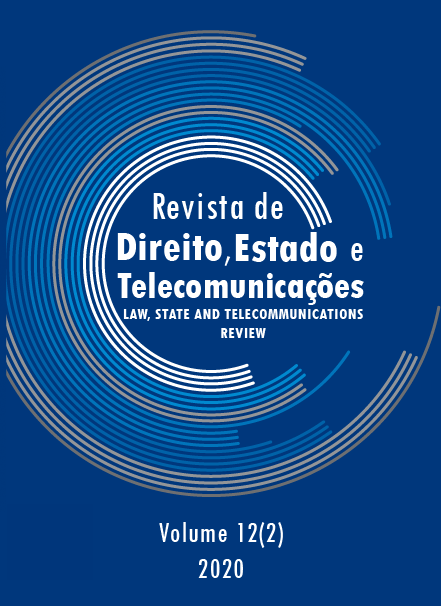INCLUSÃO DESIGUAL
UMA ANÁLISE DA TRAJETÓRIA DAS DESIGUALDADES DE ACESSO, USO E APROPRIAÇÃO DA INTERNET NO BRASIL
DOI:
https://doi.org/10.26512/lstr.v12i2.34718Palavras-chave:
Brecha Digital. Desigualdade. Uso de TIC no Brasil.Resumo
Propósito ”“ O artigo tem como objetivo avaliar a evolução da brecha digital no Brasil na última década, sob uma perspectiva multidimensional, para além da questão do acesso. Como as desigualdades no uso da Internet no Brasil variaram com o tempo?
Metodologia ”“ O estudo investiga a relação entre características socioeconômicas individuais e características domésticas e o padrão de acesso e uso da Internet no Brasil usando análise multivariada, com base em dados de pesquisas nacionais de TIC entre os anos 2000 e 2019.
Resultados ”“ Os resultados indicam que o aumento do acesso não resulta necessariamente em uma adoção e uso mais equitativos dos recursos on-line disponíveis. Também destacam uma persistente “elite digital” capaz de um uso mais sofisticado da Internet. A manutenção ”“ e até o aumento ”“ de diferenças no uso da Internet está alinhada com parte da literatura sobre inclusão digital.
Implicações Práticas ”“ O estudo aponta a importância de desenvolver marcos metodológicos para medir melhor as desigualdades digitais, o que possibilita que seja usada como variável independente em análises mais amplas da desigualdade de renda e acesso a serviços públicos, por exemplo. Além disso, a persistência de uma "brecha digital de segundo nível" no Brasil aponta para a necessidade de políticas que atendam à "desigualdade de habilidades digitais", permitindo assim, a realização do potencial da Internet para diminuir as disparidades sociais.
Originalidade ”“ Apesar da literatura existente sobre a relação entre desigualdades on-line e outros tipos de desigualdades, ainda são poucos os estudos empíricos, especialmente com uma perspectiva multidimensional.
Downloads
Referências
AABERGE, R., & BRANDOLINI, A. Multidimensional poverty and inequality. In Handbook of income distribution, vol. 2, p. 141-216. Elsevier, 2015.
ATKINSON, A. B. Multidimensional deprivation: contrasting social welfare and counting approaches. The Journal of Economic Inequality, vol. l, n. 1, p. 51-65, 2003.
BARBOSA, A. F., HATADANI, I. M., KUBOTA, L. C. & SENNE, F. Uso de tecnologias da informação e comunicação pelos jovens brasileiros. In SILVA, E. R. A. da & BOTELHO, R. U. (eds.). Dimensões da Experiência Juvenil Brasileira e Novos Desafios à s Políticas Públicas. Brasília: Ipea, 2016.
BARRANTES, R., GALPERIN, H. & MARISCAL, J. The Internet and Poverty: Opening the Black Box. Victoria: DIRSI, 2014.
CELESTE, C., DIMAGGIO, P., HARGITTAI, E. & SHAFER, S. From Unequal Access to Differentiated Use: Literature Review and Agenda for Research on Digital. New York: Russell Sage Foundation, 2004. Retrived from: https://bit.ly/3bZQ4Bf.
CGI.BR. Pesquisa sobre o uso das tecnologias de informação e comunicação - TIC Domicílios 2019. São Paulo: Comitê Gestor da Internet no Brasil, 2020.
DECANCQ, K., FLEURBAEY, M., & SCHOKKAERT, E. Inequality, income, and well-being. In Handbook of income distribution, vol. 2, p. 67-140. Elsevier, 2015.
DIMAGGIO, P., & HARGITTAI, E. From the ‘Digital Divide’ to ‘Digital Inequality’: Studying Internet Use As Penetration Increases. Working Paper #15, Summer 2001. Princeton University: Center for Arts and Cultural Policy Studies, 2001. Retrived from: https://bit.ly/2RsKm1j.
GALPERIN, H. Sociedad Digital: Brechas y Retos para la Inclusión Digital en América Latina y el Caribe. Organización de las Naciones Unidas para la Educación, la Ciencia y la Cultura. Montevideo: Cetic.br/NIC.br, 2017. Retrived from: https://bit.ly/3hrPihy.
HARGITTAI, E.& HSIEH, Y. P. Digital Inequality. In DUTTON, W. H. (ed.) The Oxford Handbook of Internet Studies. Oxford, UK: Oxford University Press, p. 129”“150, 2013.
HELSPER, E. J. (2014). Digital Inclusion in Europe: Evaluating Policy and Practice. London School of Economics Media Policy Blog, 2014. Retrived from: https://bit.ly/32vF5w7.
HELSPER, E. J. & VAN DEURSEN, A. The Third-Level Digital Divide: Who Benefits Most from Being Online? In ROBINSON, L; COTTEN, SR & SCHULZ, J. (eds.). Communication and Information Technologies Annual. Studies in Media and Communications, vol. 9, Emerald, p. 29-52, 2015.
______. Collateral Benefits of Internet use: Explaining the Diverse Outcomes of Engaging with the Internet. New Media & Society, vol. 20, n. 7, p. 2333-235, 2017.
INSTITUTO BRASILEIRO DE GEOGRAFIA E ESTATÃSTICA. Acesso à Internet e Posse de Telefone Móvel Celular para Uso Pessoal ”“ 2005. Pesquisa Nacional por Amostra de Domicílios. Rio de Janeiro: IBGE, 2007. Retrived from: https://bit.ly/2Rr1pRt.
INTERNATIONAL TELECOMMUNICATION UNION. Manual for Measuring ICT Access and Use by Households and Individuals ”“ 2014 Edition. Handbooks on Telecommunications Development. Geneva, 2014. Retrieved from https://bit.ly/3klnWM0.
MARQUES, E. Redes Sociais no Brasil: Sociabilidade, Organizações Civis e Políticas Públicas. São Paulo: Centro de Estudos da Metrópole, 2012.
SELWYN, N. Reconsidering Political and Popular Understandings of the Digital Divide. New Media & Society, vol. 6, n. 3, p. 341-362, 2004.
UNITED NATION. UN E-Government Survey 2018. Department of Economic and Social Affairs: New York, 2018. Retrieved from: https://bit.ly/3iztGRN.
VAN DEURSEN, A., & VAN DIJK, J. The Digital Divide Shifts to Differences in Usage. New Media and Society, vol. 16, n. 3, p. 507-526, 2014.
VAN DIJK, J. The Deepening Divide: Inequality in the Information Society. London: Sage, 2005.
______. The Evolution of the Digital Divide: The Digital Divide Turns to Inequality of Skills and Usage. In BUS, J; CROMPTON, M; HILDEBRANDT, M & METAKIDES, G (eds). Digital Enlightenment Yearbook 2012. Amsterdam: IOS Press, p. 57-78, 2012.
WESSELS, B. The Reproduction and Reconfiguration of Inequality: Differentiation and Class, Status and Power in the Dynamics of Digital Divides. In RAGNEDDA, M. AND MUSCHERT, G. W. (eds.) The Digital Divide: the Internet and Social Inequality in International Perspective. Series: Routledge Advances in Sociology. Routledge (Taylor & Francis Group): London, pp. 17-28, 2013.
WORLD BANK. World Development Report 2016: Digital Dividends. World Bank Publications, 2016. Retrived from: https://bit.ly/2ZDu3mX.
WORLD WIDE WEB FOUNDATION. The Webindex Report 2014-15. Retrieved from https://bit.ly/2ZCUwAS.
Downloads
Publicado
Como Citar
Edição
Secção
Licença
Direitos de Autor (c) 2020 Revista de Direito, Estado e Telecomunicações

Este trabalho encontra-se publicado com a Licença Internacional Creative Commons Atribuição 4.0.
By submitting this paper to the Law, State and Telecommunications Review,
I hereby declare that I agree to the terms of the Creative Commons Attribution 4.0 International (CC BY 4.0).


